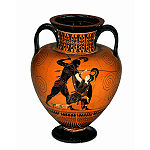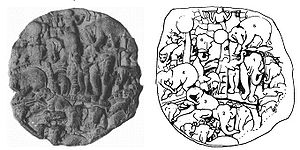- Narrative art
-
Narrative art is art that tells a story, either as a moment in an ongoing story or as a sequence of events unfolding over time. Some of the earliest evidence of human art suggests that people told stories with pictures. However, without some knowledge of the story being told it is very hard to read ancient pictures because they are not organized in a systematic way like words on a page, but rather can unfold in many different directions at once.
Pictures do not naturally lend themselves to telling stories as stories are told over time (diachronic) and pictures are seen all at once (synchronic). Although there are some common features to all narrative art, different cultures have developed idiosyncratic ways to discern narrative action from pictures. Prior to the advent of literacy most narrative art was done in a simultaneous narrative style with very little over arching organization. Once literacy developed in different parts of the world pictures began to be organized along register lines, like lines on a page, that helped define the direction of the narrative.
This method of linking scenes together led to a popular ways of telling stories in the 20th century, the newspaper, comic strips and comic books.
Contents
Types of Narrative Art
Narratives occur in a space and unfold in time. In narrative art, the artist chooses how to portray the story, represent the space, and how to shape time within the artwork.[1] Narrative art can be categorized into various types, also known as modes or styles. A piece of artwork is not limited to only one type of narrative. An artwork may have a narrative type as a whole, as well as portions of the artwork itself that depict separate types of narratives.
- Simultaneous Narrative
- Monoscenic Narrative
- Continuous Narrative
- Synoptic Narrative
- Panoptic Narrative
- Progressive Narrative
- Sequential Narrative
It important to understand that landscape is not the same as a “place” or “scene”. A depicted action in itself can suggest a different scene or setting. The quote below is a good explanation of this way of understanding scenes in narrative artwork.- “You can imagine the Trojan War taking place at Troy without having to depict the actual city of Troy.
- You can show Achilles dragging Hector’s body around the city of Troy without having to depict the
- walls of the city. Nonetheless, the idea that each action is limited to a specific place can still pertain,
- because the Trojan War did take place at Troy and Achilles did drag Hector’s body around the city.”[2]
Simultaneous Narrative
A simultaneous narrative is a type of narrative that has very little visually discernable organization to those who are not acquainted with its purpose. It can focus on geometric or abstract designs as well as the placement or arrangement of items within the artwork. Simultaneous narratives concentrate on repeatable patterns and redundant systems with a focus on dualities.[3] The interpretation of a simultaneous narrative is dependent on the reason for its creation or its creator because this would convey who would be able to interpret it as it was meant to be.
This type of narrative is common in cultures that are oral in nature rather than literate. This is because simultaneous narratives require human agency in order to be understood as originally intended. This is common in illiterate societies because of a lack of ways to transpire information from one generation to another without a written language. Thus simple patterns and dualities are used because they can be easily remembered and referenced to by those for whom the piece of art is meant.
Lukasa
A Lukasa is a mnemonic device, a device that is used as mind memory or learning aid. It is often referred to as a memory board. Because it is mnemonic, it relies on simple patterns and associations so that it may be remembered easier. Lukasa fulfilled many mnemonic functions and because of this can be interpreted many ways. While the type of information represented on a Lukasa can be generally agreed on by interpreters, the meaning of bead patterns and carvings are very much dependent on the creator. Though, there is evidence of size and shape standardizations of the board itself, not its content, among tribes.[4] Lukasa can contain secret information, genesis myths, and organizational structures. In order to retain a proper interpretation of a Lukasa it must be orally transcribed to the next generation interpreter. If the original interpreter were to die without passing on the meaning of the arrangement of beads and carvings, the meaning might be lost and never properly realized.
Lukasa focus on patterns. This makes them easier for the interpreter to remember the meaning within the Lukasa. In Lukasa beads can be arranged in three ways: a large bead surrounded by smaller beads, a line of beads, and one isolated bead.[5] Each pattern conveys some sort of information. Holes and carvings in the board were also used as means to convey information.
Dualities were also displayed within the Lukasa. One prime example is that suggest a longitudinal division that separates the board into female, Bene Nyembo, and male, Bene Kahungo, parts. It can have either male of female qualities. A male memory board has a phallic symbol protruding in the center bottom half of the board, while a female memory board would have a carved whole where someone was usually hidden( medicine or metal). These boards could be mated, even with boards that are from tribes or societies a good distance away. This is evidence of standardized design and the use of common symbols and patterns to help comprehension.[6] Dualities are also seen in a horizontal division which represent many ideas including spirit and the life realm, good and bad, past and present.
Monoscenic Narrative
A monoscenic narrative is a type of narrative that represents a single scene. There is no repetition of characters and there is only one action taking place. The scene is one that is easily identifiable in context of the narrative and is of significant importance.
Under this definition most art that is usually not considered a narrative would fit under the monoscenic narrative type. It is important to stress that narrative art is art that tells a story, either as a moment in an ongoing story or as a sequence of events unfolding over time. This in retrospect makes a good portion of art narrative art. Landscapes and portraits however do not meet the criteria of the definition provided, though might be depending on the artist’s intention.
Achilles kills Penthesilea(amphora) by Exekias
Exekias was an ancient Greek vase-painter and potter. A good portion of his vase work included scenes from Greek mylthology. He was known for his ability to capture the most critical points of a story and illustrate them into one simple scene. The amphora portraying Achilles kills Penthesilea is such an example.
This monoscenic narrative illustrated on this amphora exemplifies a vital part of the Trojan saga. It is the moment in which Achillies and Penthesilea fall in love. In the heat of battle, Achillies battles Penthesilea and with a fatal blow, causes her helmet to be pushed back. When their eyes meet it is said that they fell in love. This, of course, is ruined by Achillies’ inability to control his bloodlust. Due to this tragedy Achillies refuses to fight and from this many consequences arise that eventually could be linked to his demise.
Continuous Narrative
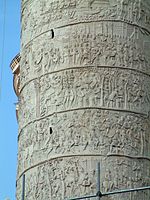 Trajan's Column is an example of a continuous narrative
Trajan's Column is an example of a continuous narrative
A continuous narrative is a type of narrative that illustrates multiple scenes of a narrative within a single frame. Multiple actions and scenes are portrayed in a single visual field without any dividers. The sequence of events within the narrative is defined through the reuse of the main character or characters. It emphasizes the change in movement and state of the repeating characters as indicators of scene or phase changes in the narrative.[7]
Column of Trajan
The Column of Trajan depicts one event: the Dacian Wars. This continuous narrative can be broken down into a series of events. These events flow from one scene to another without any physical indicators such as vertical lines. Because of how the narrative is read, from standing in front of the column, it seems to ebb right to left and then left to right which is common in continuous narratives.[8]
The narrative becomes rather hard to read as the column gets higher. Research suggests that the column was originally planned to be read while walking a circular staircase around the column itself .[9] The story then would not ebb and continue on in a sequential manner.
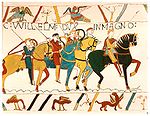 A segment from the Bayeux Tapestry
A segment from the Bayeux Tapestry
Bayeux Tapestry
One of the most famous embroideries is the 'Bayeux Tapestry'. Ironically it is misnamed with the word tapestry in it. It tells the story of the Norman invasion of England in 1066. The theme of the Bayeux Tapestry is treason and deception.[10] The narrative reflect the Norman view on the conquest of England. Thought the tapestry seems to be framed because it is separated by registers, horizontal lines, it is still a continuous narrative. Registers are needed in order to separate a story to fit within a certain area. If cut up and placed next to each other, a continuous narrative would exists. A continuous narrative does not have any dividers between scenes and actions, vertical dividers, which create a frame.
Synoptic Narrative
A synoptic narrative depicts a single scene in which a character or characters are portrayed multiple times within a frame to convey that multiple actions are taking place. This causes the sequence of events to be unclear within the narrative. Synoptic narratives typically provide visual cues that convey the sequence, but still might be difficult to decipher for those unfamiliar with the story.[11]
Chaddanta Jataja, Amaravati
An instance of a synoptic narrative is one represented in a medallion from the stupa at Amaravati.[12] It , like many synoptic narratives, can be difficult to interpret. The medallion is meant to present the reader with the story of Buddha’s previous birth as the elephant Chaddanta. The center of the medallion has only decorative carving, which is a visual queue on how the medallion is meant to be interpreted; which is in a circular pattern. Other than that subtle visual queue the artist leaves very little indication of the order.
The medallion can be separated into 3 episodes:
- 1 - Chaddanta presents his chief queen with lotus.
- 2 - Junior queen in offended.
- 3 – She, the junior queen, leaves to be on her own.
- 4 – She lays dying, hoping for revenge.
- 5 – A hunter aims an arrow at Chaddanta.
- 6 – The hunter saws off Chaddanta’s tusks.
- 7- The hunter is seen departing with the tusks. (This isn’t numbered but is at the very top center)[13]
Panoptic Narrative
A panoramic narrative is a narrative that depicts multiple scenes and actions without the repetition of characters. Actions may be in a sequence or represent simultaneous actions during an event.
Siphnian Treasury North Frieze
The Siphnian Treasury is well known for the marble friezes it houses atop its structure. The treasury has four friezes, one for each cardinal direction. These four friezes depict panoramic narratives through the use of carvings of the marble. The north frieze is an illustration of a battle between the Olympic gods and the giants. In the far left two giants attack Zeus in his chariot, who is no longer visible due to deterioration. Hera is seen finishing off a giant to the right of Zeus with Athena behind her (further right) fighting two giants. To the right of Athena is her brother Ares who is fighting two other giants with one already dead at his feet.
This exemplifies the mode of panoramic narrative. There are multiple narratives taking place with each combatant in varying scenes. The dead giant at Ares feet was downed by Athena but Ares is depicted as moving forward in the narrative by stepping over the corpse.[14]
Progressive Narrative
A progressive narrative portrays a single scene in which characters do no repeat. However, multiple actions are taking place in order to convey a passing of time in the narrative. A progressive narrative is not to be interpreted as group of simultaneous events but rather a sequence that is dependent on its location.[15] Actions displayed by characters in the narratives compact present and future action into a single image.
Sequential Narrative
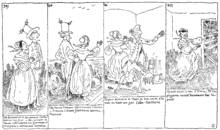 A page by Rodolphe Töpffer, whose is well known for his amazing ability to create sequential narratives.
A page by Rodolphe Töpffer, whose is well known for his amazing ability to create sequential narratives.
A sequential narrative is very much like a continuous narrative with one major difference. A sequential narrative focuses on enframement to develop temporal development while a continuous requires criteria provided by the image itself.[16] Each scene and action is represented within its frame as a unit. Each frame is a particular scene during a particular moment.
A sequential narrative is the type of narrative used in comics and manga.
Notes
- ^ Vidya Dehejia 1990, p. 375
- ^ Jocelyn Penny Small 1999, p. 571
- ^ Petersen, 2010
- ^ Reefe 1977, p. 50
- ^ Reefe 1977, p. 48
- ^ Reefe 1977, p. 48
- ^ Vidya Dehejia 1990, p. 386
- ^ Jocelyn Penny Small 1999, p. 571
- ^ Jocelyn Penny Small 1999, p. 571
- ^ Dodwell 1966, p. 554
- ^ Vidya Dehejia 1990, p. 382
- ^ Vidya Dehejia 1990, p. 383
- ^ Vidya Dehejia 1990, p. 383
- ^ Petrakos 1977, p. 47
- ^ Jocelyn Penny Small 1999, p. 571
- ^ Vidya Dehejia 1990, p. 386
References
- Dehejia, Vidya. ” On Modes of Visual Narration in Early Buddhist Art”. The Art Bulletin, Vol. 72, No. 3 (Sep., 1990), pp. 374–392
- Petersen, Robert. “Early Visual Literacy”. History of Graphic Novels EIU4171G Class. Eastern Illinois University, Charleston, IL. 2010.
- Small, Jocelyn Penny. “ Time in Space: Narrative in Classical Art”. The Art Bulletin, Vol. 81, No. 4 (Dec., 1999), pp. 562–575.
- Connelly, Joan B.. “Parthenon and Parthenoi: A Mythological Interpretation of the Parthenon Frieze”. American Journal of Archaeology, Vol. 100, No. 1 (Jan., 1996), pp. 53–80
- Petrakos, Basil. Delphi. Athens: CLIO Editions, 1977. Print.
- Reefe, Thomas Q.. “Lukasa: A Luba Memory Device”. African Arts, Vol. 10, No. 4 (Jul., 1977), pp. 48–50+88
- Dodwell C. R. “The Bayeux Tapestry and the French Secular Epic.” The Burlington Magazine, Vol. 108, No. 764 (Nov., 1966), pp. 549–560
Bayeux Tapestry
One of the most famous embroideries is the 'Bayeux Tapestry'. Ironically it is misnamed with the word tapestry in it. It tells the story of the Norman invasion of England in 1066.
-
A segment from the Bayeux Tapestry. There are many segments but these are too large to be displayed. Link to site from origen
Categories:- Narrative forms
Wikimedia Foundation. 2010.

